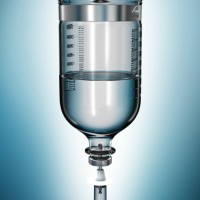For the past 70 years, intravenous (IV) infusions and injections have been the most popular way to get high doses of vitamin C into the body. Unlike oral vitamin C – which is not efficiently absorbed by the body, and is mostly passed as waste – IV delivery puts 100% of the vitamin C directly into the blood.
Contrary to popular belief, 100% delivery into the blood does not necessarily mean the vitamin C is 100% bioavailable. And bioavailability is what really matters.
The Importance of Being Bioavailable
Bioavailability is the amount of a substance that is absorbed by a target location within the body. This target location can be in the blood, cells, tissue, etc. The target location for some nutrients is the blood, and for these nutrients IV delivery makes them 100% bioavailable. But for vitamin C, the target location is typically inside the cell – where free radicals, toxins, and pathogens do the most harm. The problem is that IV delivery puts all of the vitamin C directly into the blood, but it does not guarantee direct access into the cells.
Once in the bloodstream, vitamin C relies on transport proteins to carry it through special doorways that lead to the inside of cells. Transport proteins can only carry one molecule of vitamin C through one doorway at a time. And the number of transport proteins and doorways is limited. Due to these limitations, delivery into the cells may be restricted, meaning the bioavailability of the vitamin C is also restricted.
But Wait, There’s More…
It’s also important for the vitamin C that actually makes it inside the cell to be in its active (reduced) form. If the vitamin C has become inactive (oxidized) during transport, it has lost the electrons it needs to function properly. To become active again, the vitamin C must take electrons from other antioxidants inside the cell (i.e. glutathione). Since the whole point of IV vitamin C is to increase the amount of active antioxidants in the body, this process is a bit inefficient.
Furthermore, the entire process of transporting vitamin C into the cells and reactivating inactive vitamin C uses a substantial amount of energy within the cell. An ample supply of cellular energy is necessary to maintain life, so the energy used in this process needs to be replaced as quickly as possible.
With all of this said, IV delivery of vitamin C still offers a significant advantage over most oral delivery systems, and it is still the preferred delivery method when large amounts of vitamin C are needed in the blood. But if you want to get high doses of vitamin C delivered into the blood and the cells, you can take liposome encapsulated vitamin C.
Liposome Encapsulated Vitamin C
 Liposomes are tiny spheres with double-layer membranes made from Essential Phospholipids. Active vitamin C is encapsulated inside the liposome, and protected from destruction in the digestive system. Because the liposome membrane is made of phospholipids – the same material that makes up the cellular membrane – the liposome is able to incorporate itself directly into the cell membrane. When this happens, the active vitamin C that’s inside of the liposome is delivered directly into the cell.
Liposomes are tiny spheres with double-layer membranes made from Essential Phospholipids. Active vitamin C is encapsulated inside the liposome, and protected from destruction in the digestive system. Because the liposome membrane is made of phospholipids – the same material that makes up the cellular membrane – the liposome is able to incorporate itself directly into the cell membrane. When this happens, the active vitamin C that’s inside of the liposome is delivered directly into the cell.
Since the liposome can deliver vitamin C directly into the cell in its active form (it has all of its electrons), it does not rely on transport proteins to carry the vitamin C across the cellular membrane and it does not use a lot of cellular energy.
Used together, IV vitamin C and liposome encapsulated vitamin C optimize the level of active vitamin C in the body. But if IV vitamin C is not an option for you, high doses of liposome encapsulated vitamin C can offer significant benefits on its own.






